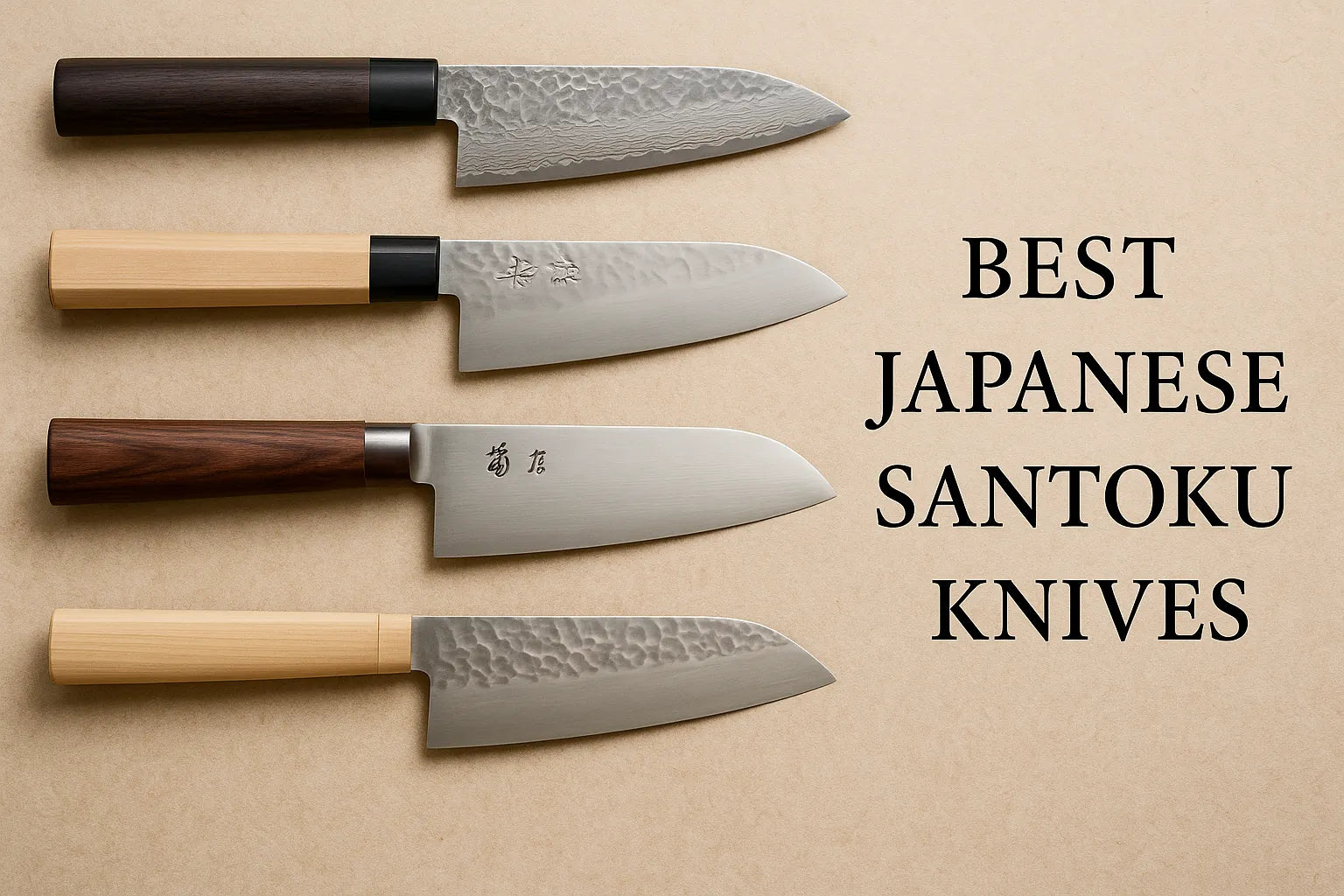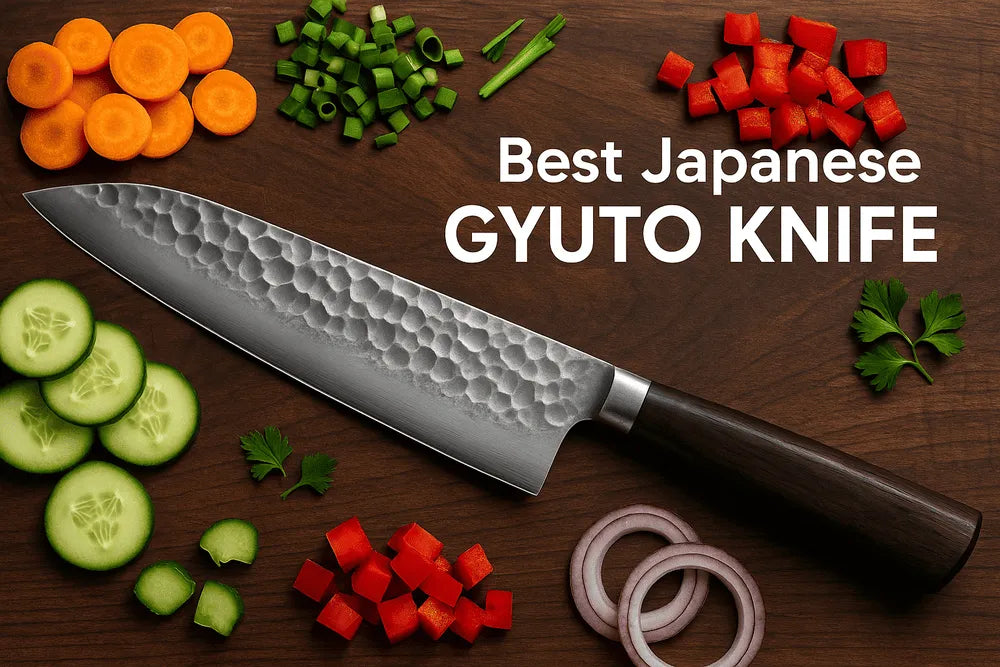Which knife should you choose: Gyuto vs Santoku? Both are popular Japanese kitchen knives designed for everyday cooking, yet they feel very different in hand. A Gyuto knife offers length, balance, and precision for cutting meat and larger vegetables, while a Santoku knife gives comfort and control for quick home prep.
Understanding the real differences between Gyuto vs Santoku helps you choose the right tool for your cooking style. Keep reading to learn how each performs in daily kitchen use.
1. What is a Gyuto Knife?
The Gyuto knife is Japan’s version of the Western chef’s knife. The word Gyuto (牛刀) means “cow sword,” reflecting its original use for slicing large cuts of beef. Today, it’s known as one of the most versatile knives in both professional and home kitchens.

Key design features:
- Blade length: Usually between 210–240 mm, giving the knife long reach and control.
- Blade shape: A gently curved belly allows a rocking motion when chopping.
- Tip design: A pointed tip helps with precise cuts and trimming.
Best uses:
- Ideal for cutting meat, fish, and large vegetables.
- Performs well with both push-cutting and rocking techniques.
The Gyuto combines Japanese precision with Western versatility, making it the go-to knife for anyone who cooks daily or professionally.
Read our guide on the Best Japanese Gyuto Knives to find the perfect chef’s knife for your cooking style.
2. What is a Santoku Knife?
The Santoku knife is one of Japan’s most popular kitchen knives. The name Santoku (三徳) means “three virtues,” referring to its ability to handle meat, fish, and vegetables, the core ingredients in everyday cooking.

Key design features:
- Blade length: Typically 165–180 mm, shorter than a Gyuto for better control.
- Edge profile: A mostly flat edge with minimal curve, ideal for straight chopping.
- Tip design: A sheep’s foot tip with a gentle downward curve for safety and precision.
Best uses:
- Excellent for slicing, dicing, and mincing smaller ingredients.
- Designed for quick, up-and-down chopping rather than rocking cuts.
The Santoku offers comfort and balance, making it a favorite for everyday meal prep. Its design gives confidence to beginners while staying efficient enough for experienced cooks.
Explore the Top 8+ Best Santoku Knives Reviewed by Experts and pick the right one for your home kitchen.
3. Quick Feature Comparison: Gyuto Knife vs Santoku Knife
The table below highlights the main differences between a Gyuto knife and a Santoku knife. Both knives excel in everyday cooking, but their design and feel suit different techniques and users.
|
Feature |
Gyuto Knife |
Santoku Knife |
|
Blade Length |
210–270 mm (longer reach) |
165–180 mm (shorter, easier control) |
|
Blade Profile |
Curved belly for rocking motion |
Flat edge for push-cutting and chopping |
|
Tip Design |
Sharp, pointed tip for precision work |
Rounded sheep’s foot tip for safety and smooth cuts |
|
Weight & Balance |
Slightly heavier; balanced toward the center |
Lighter; balance favors quick, vertical motions |
|
Cutting Motion |
Suited for rocking and slicing |
Ideal for straight chopping and push-cutting |
|
Knuckle Clearance |
Moderate; depends on knife size |
Higher, better clearance for fast chopping |
|
Typical Tasks |
Large cuts of meat, fish fillets, and big vegetables |
Everyday prep like dicing onions, mincing garlic, slicing fruit |
|
User Suitability |
Professionals or skilled home cooks |
Beginners and home cooks who want control and comfort |
Both knives can handle most kitchen tasks, but the Gyuto shines in precision and versatility, while the Santoku offers comfort, control, and speed for daily cooking.
4. Detailed Comparison Between Gyuto and Santoku Knives
The Gyuto and Santoku knives are both versatile kitchen tools, but their designs influence how they perform in daily cooking. Below, we break down their main differences in blade length, shape, comfort, and cutting style to help you understand which fits your cooking habits best.
4.1 Blade Shape and Tip Design
Blade shape and tip design influence how each knife moves through food. The Gyuto features a curved edge with a sharp point, while the Santoku has a flatter edge and a rounded tip.

Gyuto Knife:
- The curved edge supports rocking motions, perfect for slicing herbs, garlic, and meats in a continuous rhythm.
- Its pointed tip provides precision for fine work such as trimming fat or piercing ingredients.
- The sharp tip requires more care from beginners to avoid accidents during fast chopping.
Santoku Knife:
- The flat edge works best for up-and-down chopping or push-cutting.
- The rounded sheep’s foot tip gives a sense of safety and control, especially for home cooks.
- Less suited for piercing or intricate tasks but better for clean, fast cuts on soft vegetables and fruits.
You should use the Gyuto for curved slicing and detailed prep. Choose the Santoku for straight chopping and simple control.
4.2 Blade Length and Cutting Surface
Blade length directly affects how efficiently a knife handles different ingredients and cooking tasks. The Gyuto is generally longer, while the Santoku is shorter and easier to control.

Gyuto Knife:
- Measures around 210 to 270 mm, offering more reach and flexibility for a variety of foods.
- The longer cutting surface allows smooth slicing through large vegetables or full cuts of meat in one stroke.
- Great for professional chefs or experienced cooks who need space and efficiency.
- The extra length, however, can make it slightly harder for beginners to handle, especially in small kitchens.
Santoku Knife:
- Usually 165 to 180 mm, making it compact and well-suited for everyday prep.
- The shorter blade gives better control when cutting smaller ingredients like onions, herbs, or fruit.
- More comfortable for cooks with limited counter space or smaller hands.
- However, the shorter surface means extra strokes are needed when slicing larger items.
If you want more reach and cutting speed, choose the Gyuto. If you prefer compact control and balance, the Santoku fits better.
4.3 Comfort and Handle Ergonomics
Knife comfort depends on how well it fits your hand and cutting habits. Both knives are designed for balance, but they feel different depending on the user’s grip and skill level.

Gyuto Knife:
- Balanced weight between blade and handle, suitable for both pinch and hammer grips.
- The thinner spine and longer handle provide smoother transitions for professional chefs.
- Works well for cooks who spend long hours prepping ingredients.
Santoku Knife:
- The taller blade gives extra knuckle clearance, reducing strain when chopping on a cutting board.
- Its lighter weight and compact body make it ideal for cooks with smaller hands.
- Easier to maneuver and less tiring during repetitive chopping.
If you value comfort and control, the Santoku feels easier to handle. The Gyuto offers a better balance for those who are confident with larger, heavier blades.
4.4 Cutting Style and Task Performance
Your cutting technique determines which knife performs better. Each blade supports different motions and excels in particular kitchen tasks.

Gyuto Knife:
- Designed for a rocking or sliding motion, allowing fluid cutting of meats, herbs, and large vegetables.
- Great for tasks like carving roasts, dicing onions, or slicing sashimi.
- Excels in professional kitchens where precision and speed matter.
Santoku Knife:
- Works best with straight, up-and-down chops or gentle forward push-cuts.
- Ideal for slicing cucumbers, carrots, or mincing garlic.
- Quick and efficient for daily prep work, especially when cooking multiple dishes at home.
The Gyuto delivers smoother flow and efficiency for diverse ingredients, while the Santoku provides control and accuracy for small, repetitive cuts.
5. Pros and Cons of Each Knife
Both the Gyuto and Santoku knives are excellent all-purpose blades, but each has its strengths and trade-offs. The lists below summarize their advantages and disadvantages to help you choose based on your cooking needs, skill level, and comfort preference.
|
x |
Gyuto Knife |
Santoku Knife |
|
Pros |
|
|
|
Cons |
|
|
Choose the Gyuto if you value range and versatility in professional-style cutting. Choose the Santoku if you prefer balance, control, and comfort for everyday home cooking.
7. Decision Guide: Which Should You Buy First?
Both the Gyuto and Santoku knives can handle almost every kitchen task, but the best choice depends on how you cook, the space you have, and how comfortable you are with knife handling. The guide below will help you decide which knife to start with based on your personal needs.
Choose a Gyuto Knife if you:
- Cook frequently and handle a wide variety of ingredients.
- Prepare larger cuts of meat, fish, or big vegetables like pumpkins or cabbage.
- Prefer a rocking cutting motion for smooth, continuous slices.
- Want a knife that performs like a traditional Western chef’s knife but with Japanese balance and sharpness.
- Have a spacious kitchen or a cutting board that accommodates a longer blade.
- Don’t mind spending extra time maintaining and sharpening the knife.
Best for:
- Professional chefs, culinary students, and experienced home cooks who want versatility and range.
- Users who want one knife that can replace several specialized tools.
Choose a Santoku Knife if you:
- Focus mainly on quick daily meal prep and smaller portions.
- Work in a compact kitchen or prefer shorter blades for better control.
- Like a push-cut or straight-chop motion instead of rocking cuts.
- Have smaller hands or want a lighter, easier-to-handle knife.
- Need a safe and comfortable option for beginners or family cooking.
- Prefer a lower-maintenance knife that is easy to sharpen and store.
Best for:
- Home cooks, casual users, or anyone new to Japanese knives.
- Those who prioritize comfort and precision over reach.
Final Words
Both Gyuto and Santoku knives are versatile and reliable tools, but the better choice depends on how you cook. A Gyuto knife fits chefs who need reach and precision for various ingredients. A Santoku knife suits home cooks who prefer speed and simplicity for everyday tasks. Try holding each style to see which feels more natural to your grip and cutting motion. Explore authentic Gyuto and Santoku knives at Lewis Knife and find the perfect blade for your kitchen.
FAQs
-
A Santoku knife is generally better for beginners. It’s shorter, lighter, and easier to control, especially for quick chopping or slicing vegetables. The rounded tip also feels safer for new users. Once you’re comfortable with knife handling, a Gyuto knife offers more versatility and reach for advanced cutting tasks.
-
Yes, for most home kitchens. A Santoku knife can perform nearly all the same tasks as a Western chef’s knife, from chopping onions to slicing meat or dicing herbs. However, it’s shorter and flatter, so it’s less effective for rocking cuts. If you prefer longer strokes and larger ingredients, a Gyuto knife is a better replacement for a traditional chef’s knife.
-
Yes. The Bunka knife is a popular hybrid option. It combines the compact body of a Santoku with a pointed tip similar to a Gyuto. This gives you precision for detailed work and comfort for everyday prep. If you like both knife styles, the Bunka offers a balanced middle ground.



